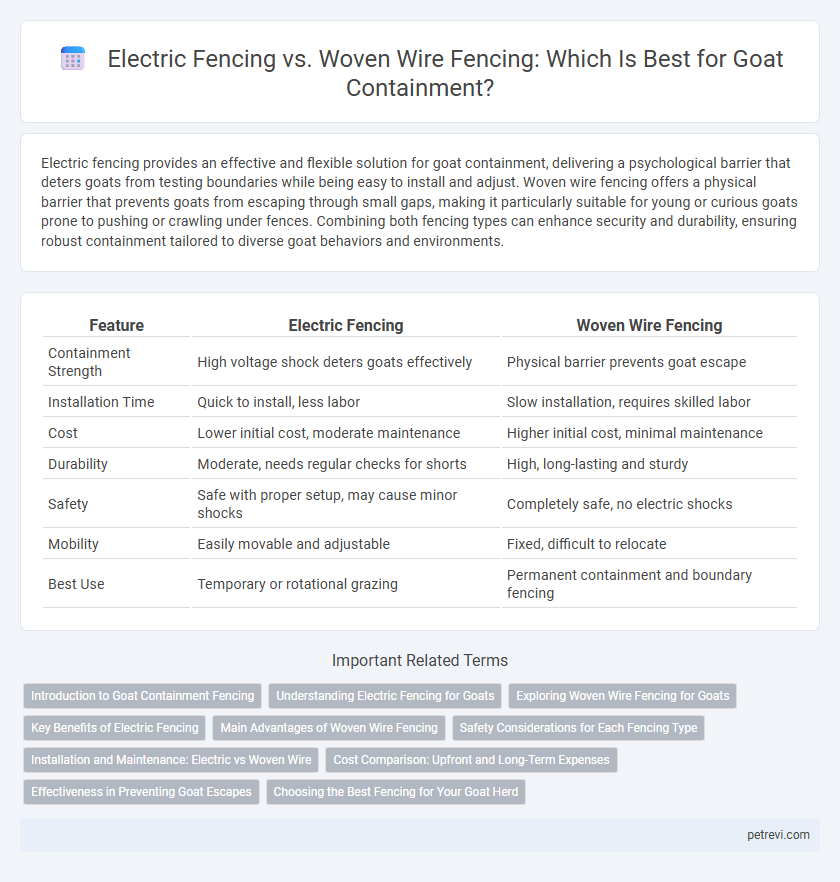Electric fencing provides an effective and flexible solution for goat containment, delivering a psychological barrier that deters goats from testing boundaries while being easy to install and adjust. Woven wire fencing offers a physical barrier that prevents goats from escaping through small gaps, making it particularly suitable for young or curious goats prone to pushing or crawling under fences. Combining both fencing types can enhance security and durability, ensuring robust containment tailored to diverse goat behaviors and environments.
Table of Comparison
| Feature | Electric Fencing | Woven Wire Fencing |
|---|---|---|
| Containment Strength | High voltage shock deters goats effectively | Physical barrier prevents goat escape |
| Installation Time | Quick to install, less labor | Slow installation, requires skilled labor |
| Cost | Lower initial cost, moderate maintenance | Higher initial cost, minimal maintenance |
| Durability | Moderate, needs regular checks for shorts | High, long-lasting and sturdy |
| Safety | Safe with proper setup, may cause minor shocks | Completely safe, no electric shocks |
| Mobility | Easily movable and adjustable | Fixed, difficult to relocate |
| Best Use | Temporary or rotational grazing | Permanent containment and boundary fencing |
Introduction to Goat Containment Fencing
Goat containment fencing requires durable and secure options to prevent escapes and predator intrusions. Electric fencing offers a flexible solution with low upfront costs and easy installation, delivering an effective psychological barrier by delivering a mild shock to deter goats. Woven wire fencing provides a physical barrier with strong, tightly spaced wires that resist climbing and rubbing, ensuring long-term security in various terrains.
Understanding Electric Fencing for Goats
Electric fencing for goats uses low-voltage pulses to create a psychological barrier, effectively training goats to avoid the fence without causing harm. This method offers flexibility in layout, allowing easy adjustments to pasture size and shape, which is particularly beneficial for rotational grazing systems. Compared to woven wire fencing, electric fencing requires less initial investment and maintenance while providing sufficient containment for most goat breeds when properly installed.
Exploring Woven Wire Fencing for Goats
Woven wire fencing offers a durable and secure barrier ideal for goat containment, preventing escapes and protecting against predators. Its closely spaced mesh design resists goat pressure and reduces the risk of injury compared to electric fencing. Proven effective for long-term use, woven wire requires minimal maintenance and provides a reliable solution for managing goat herds.
Key Benefits of Electric Fencing
Electric fencing provides superior goat containment by delivering a safe, psychological barrier that conditions goats to avoid the fence, reducing escape incidents significantly. It offers quick installation flexibility and cost-effectiveness compared to woven wire fencing, allowing for easy adjustment as herd size or grazing areas change. Electric fencing also requires minimal maintenance and promotes better pasture management through controlled rotation.
Main Advantages of Woven Wire Fencing
Woven wire fencing offers superior durability and long-term reliability for goat containment due to its robust construction resisting bending and breakage. The tight mesh design effectively prevents goats from escaping and protects them from predators by minimizing gaps. Its maintenance requirements are lower compared to electric fencing, making it a cost-effective solution for secure goat enclosures.
Safety Considerations for Each Fencing Type
Electric fencing offers a controlled deterrent that reduces risks of injury through low-voltage shocks, making it safer for goats prone to escaping but requires regular maintenance to ensure functional electrification. Woven wire fencing provides a physical barrier that minimizes the chance of goats escaping and injury from sharp edges is mitigated by selecting smooth, well-tensioned wire types, enhancing overall goat safety. Evaluating the behavior and strength of the goat herd is critical for choosing the fencing that best prevents harm and containment breaches.
Installation and Maintenance: Electric vs Woven Wire
Electric fencing for goat containment offers quicker installation with lightweight posts and simple wiring, reducing labor time compared to woven wire fencing, which requires setting heavier posts and stretching stiff wire. Maintenance of electric fences involves regularly checking battery charge, insulators, and wire tension to prevent shorts, whereas woven wire demands routine inspection for rust, sagging, and repairs from animal pressure or weather damage. Electric fencing provides flexible relocation options and cost-effective upkeep, while woven wire offers enduring physical barriers but requires more intensive maintenance efforts.
Cost Comparison: Upfront and Long-Term Expenses
Electric fencing for goat containment typically involves lower upfront costs than woven wire fencing, with material prices averaging $0.10 to $0.30 per linear foot compared to $1.50 to $3.00 per linear foot for woven wire. Long-term expenses for electric fencing include periodic battery or solar panel replacements and occasional wire repairs, whereas woven wire requires minimal maintenance but may demand higher initial labor costs and occasional patching. Overall, electric fencing offers a cost-effective solution for budget-sensitive farmers, while woven wire presents a durable investment with predictable maintenance costs over time.
Effectiveness in Preventing Goat Escapes
Electric fencing provides an effective deterrent for goat containment by delivering a mild shock that discourages goats from testing boundaries. Woven wire fencing offers a physical barrier that prevents goats from slipping through or under, but requires higher maintenance to repair damages from goat pressure. Combining electric fencing with woven wire enhances escape prevention by leveraging both behavioral deterrence and physical restraint.
Choosing the Best Fencing for Your Goat Herd
Electric fencing provides a cost-effective and flexible option for goat containment, delivering a psychological barrier that conditions goats to respect boundaries with minimal physical contact. Woven wire fencing offers a durable and secure physical barrier, ideal for preventing escapes and predator intrusion, especially in areas with heavy vegetation or aggressive goat behavior. Selecting the best fencing depends on herd size, terrain, and predator pressure, with many farmers combining both systems to optimize containment and safety.
Electric Fencing vs Woven Wire Fencing for Goat Containment Infographic

 petrevi.com
petrevi.com